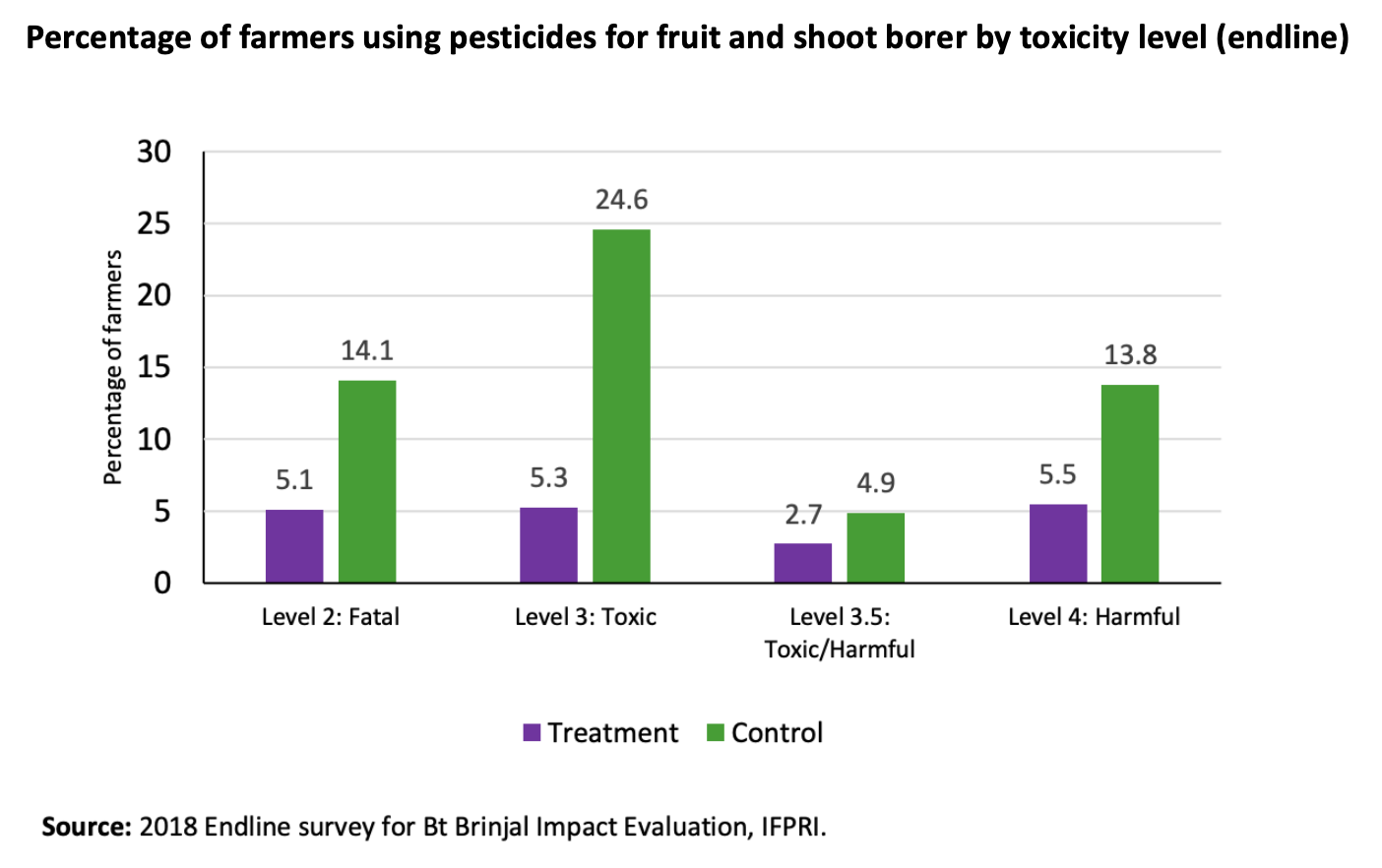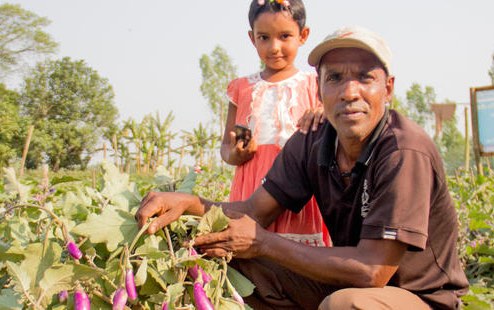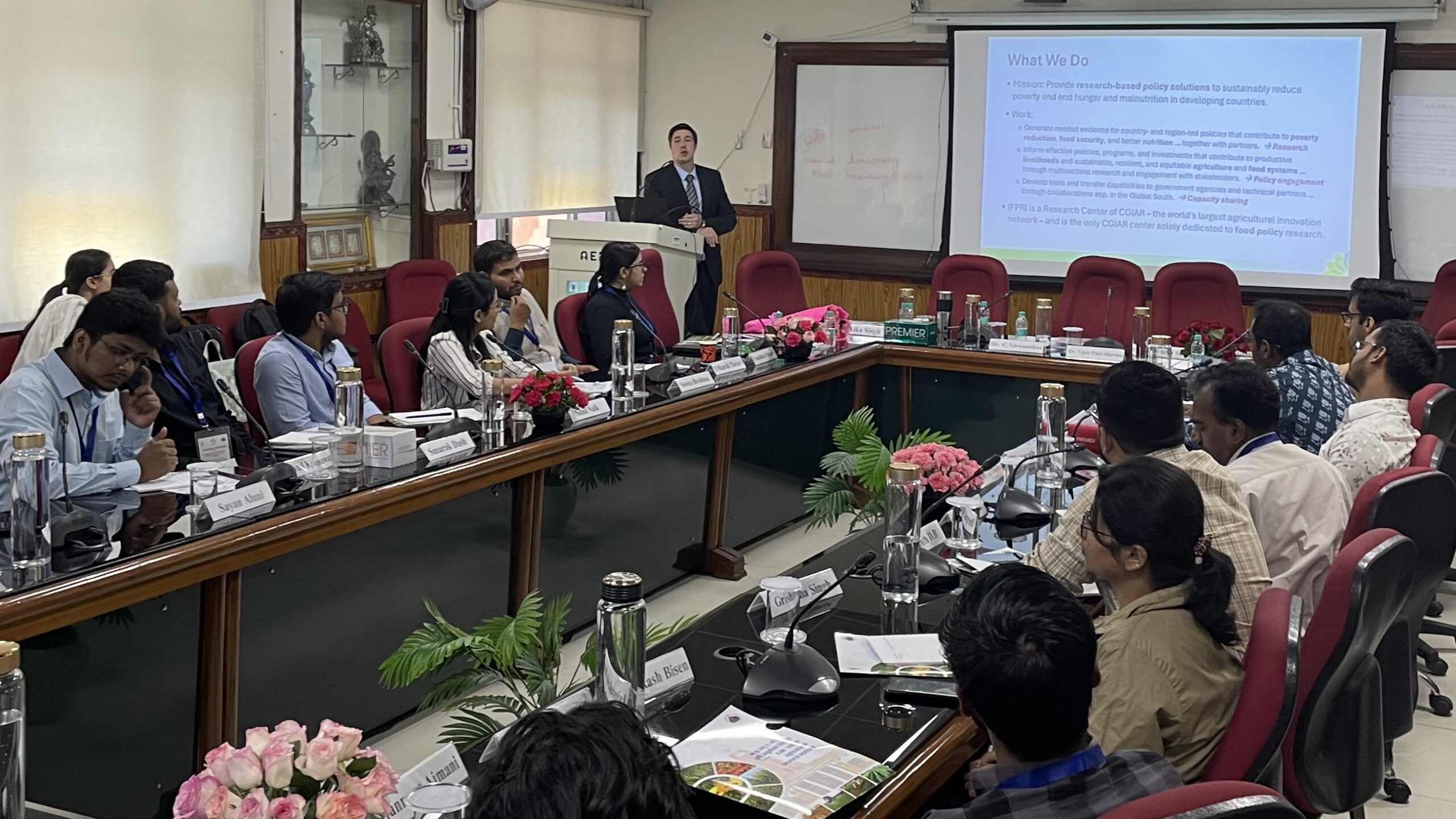Eggplant, known as brinjal in Bangladesh, is a high-value crop that is widely grown and consumed throughout the country. About 150,000 farmers grow brinjal in Bangladesh and it ranks third after potato and rice among crops in the country in terms of quantity consumed. It is a critical piece of Bangladesh’s food security puzzle.
However, brinjal is highly susceptible to the fruit and shoot borer (FSB) pest. FSB is a moth whose larvae bore into the stem and fruit of brinjal. Infestations can lead to yield losses as high as 86%, a devastating hit for smallholder farmers with whom Feed the Future works. To fight this pest, farmers spray their crops heavily with toxic pesticides. Studies have found that farmers spray from as few as 23 times to as much as 140 times per season. This intense amount of spraying can have harmful effects on the health of farmers, their families, the consumers of the fruit, and the environment.
To address this insidious pest, a diverse set of partners, including the Bangladesh Agriculture Research Institute (BARI), Maharashtra Hybrid Seeds Co. Pvt. Ltd. (Mahyco), Cornell University, and Feed the Future, developed brinjal varieties with a protein (Bt, specifically Cry1Ac) that provides protection from FSB, intended to reduce FSB infestation and the need for toxic pesticides.
Testing the efficacy of Bt brinjal
IFPRI, BARI, and the Bangladesh Department of Agricultural Extension (DAE), with support from the U.S. Agency for International Development (USAID), have now completed an independent impact evaluation, Impacts of Bt Brinjal (Eggplant) Technology in Bangladesh, to determine the impacts of Bt brinjal on pest infestation, pesticide use, crop yields, costs, revenues, and self-reported health outcomes.
The study shows exciting results of how Bt brinjal can lead to real improvements in the lives of farmers.
Bt brinjal leads to a:
- 95% reduction in FSB infestation
- 56% reduction in the environmental toxicity of pesticides used
- 10% reduction in self-reported symptoms associated with pesticide exposure among individuals in households growing Bt brinjal
- 42% increase in yields
- $400 increase in profits per hectare
Scaled up, these results imply that the cultivation of Bt brinjal could prevent the application of over 230,000 liters of pesticide nationwide.
How the study worked
IFPRI designed a randomized controlled trial (RCT) study to estimate the impacts of Bt brinjal in four districts in northwest Bangladesh where winter brinjal cultivation is prominent, physical infrastructure is relatively good, and the brinjal markets are well-functioning. Bt brinjal-4, the variety tested in this study that grows round green eggplants, is one of four Bt varieties that has been approved for cultivation in Bangladesh.
At the study outset, 1,200 farmers in 200 villages (six farmers per village) were identified as being willing to participate in the study. Half of the villages were randomly selected to grow Bt brinjal-4, and half were randomly selected to grow a conventional variety (ISD-006), identical to Bt brinjal-4, except for the genetic distinction that allows Bt brinjal-4 to repel FSB.
Farmers in the study planted their brinjal on 10 decimal plots, equivalent to 0.04 hectares or 400 square meters, in November 2017. All farmers received a small package of inputs including fertilizers, pheromone traps, sticky traps, and netting to prevent birds from eating the fruit with a value of about $24. None of the farmers received pesticide.
Replicating what would happen during the scale-up of Bt brinjal, farmers who received Bt brinjal seedlings and those who received the conventional ISD-006 seedlings were trained on the same integrated pesticide management practices by DAE officials. Farmers growing Bt brinjal also received guidance from BARI and DAE on maintaining a non-Bt brinjal border, a line of conventional brinjal grown around the Bt-brinjal plants, to help prevent insects from developing resistance to Bt.
IFPRI collected data from farmers before the study (baseline) and following the harvest season in July 2018 (endline).
A dramatic reduction in FSB infestation
At endline, the study not only showed that the Bt brinjal variety dramatically reduced FSB infestation, but it also showed reductions in pesticide use and increases in productivity and profits.
At baseline, all farmers reported an FSB infestation rate of 35.5% for the previous season.1
At endline, the rate of FSB infestation in Bt brinjal plants was only 1.8%. In contrast, the rate of FSB infestation in the non-Bt brinjal plants was 33.9%.2
Not only did the Bt brinjal ward off FSB, but it also showed lower levels of infestations from other beetles, aphids, mites, and pests.
Steep reduction in pesticide application
Although Bt brinjal farmers did not receive any special instructions on reducing pesticide use, there was a 51% reduction in the number of pesticide applications among Bt brinjal farmers. On average, they sprayed 7.4 times less than non-Bt brinjal farmers.
Bt brinjal farmers also saw a 47% reduction in the cost of applying pesticides, saving $85.18 per hectare.
Not only did the study show a reduction in the cost of applying pesticides, but it also showed that farmers applied 39% less pesticides. This means Bt brinjal farmers applied around 4,616 ml or gm per hectare less pesticides compared with non-Bt brinjal farmers.
Based on the type of pesticides and the decrease in the number of pesticides, there was a 41% reduction in the toxicity of pesticides applied, as measured by the Pesticide Use Toxicity Score, and a 56% reduction in environmental toxicity, as measured by the Field Use Environmental Impact Quotient.

The decreased use of pesticides among Bt brinjal farmers saved them money and lessened exposure to toxic pesticides for themselves, their family and the environment.
Productivity and profits increased
Net yields3 (kilograms produced per hectare of brinjal cultivated) were 42% higher for Bt brinjal farmers, equivalent to a 3,622 kg per hectare increase. These increases in net yields were widespread and occurred because Bt brinjal farmers produced more brinjal and discarded fewer fruits after harvest.
It cost Bt brinjal farmers $113.87 per hectare less to grow Bt brinjal. Much of the 31% reduction in the cost of growing a kilogram of brinjal is due to reduced pesticides.
Farmers earned an additional $400.41 per hectare in net profits. This 13.9% increase in profits is due primarily to savings from decreased pesticide cost and increased the productivity of Bt brinjal.
A reduction in symptoms consistent with pesticide exposure
Farmers and their families growing Bt brinjal reported fewer symptoms consistent with pesticide exposure.
Individuals in households growing Bt brinjal were 10% less likely to report symptoms consistent with pesticide exposure and 6.5 percentage points less likely to report that they needed to seek medical care for these symptoms. These results are statistically significant. Both men and women from households growing Bt brinjal were less likely to report symptoms consistent with pesticide exposure.
Reductions in reported symptoms were larger for individuals who, at baseline, reported symptoms related to chronic respiratory illnesses or skin disease.
Smallholder farmers in Bangladesh face constant challenges. From worsening natural disasters to depleted soils, there are frequently unexpected and expected obstacles. But for farmers who have been consistently devastated by the FSB, Bt brinjal holds promise to improve their lives, from bettering the health of their families and community and increasing their profits to lessening the impact on consumers and the environment from pesticides.
Bt brinjal could have long-term, positive impacts on the food security and health of people in Bangladesh. While the impact study results were subject to various factors during the years assessed (2017-2018), and both year-to-year and geographical variations in weather, precipitation, and other factors influence brinjal performance, if these estimates are extrapolated on a national level, reduced pesticide costs could save farmers over $2.7 million and net profits could increase farmers’ income by over $14 million.
Akhter Ahmed is the Country Representative for IFPRI-Bangladesh and Senior Research Fellow with IFPRI’s Poverty, Health, and Nutrition Division (PHND). John Hoddinott is a PHND Nonresident Fellow and H.E. Babcock Professor of Food & Nutrition Economics and Policy at Cornell University. Paul Tanger is a USAID International Agriculture Research Adviser. Lesley Perlman is a USAID Monitoring and Evaluation Program Analyst. This post first appeared on Agrilinks.
This work was funded by the U.S. Agency for International Development (USAID), the IFPRI-led CGIAR Research Program on Policies, Institutions, and Markets (PIM), and the Bangladesh Ministry of Agriculture. Note: the research has been submitted to a peer-reviewed journal but has not yet been accepted for publication.
1. For this study infestation was calculated by multiplying the percentage of plots infested by theage of plants infested on infested plots.
2. The difference in plant-level infestation between Bt brinjal and non-Bt brinjal plots is statistically significant at the 1% level.
3. Net production is quantity harvested in kg minus fruit discarded for any other reason, including damage due to pests or other diseases.







